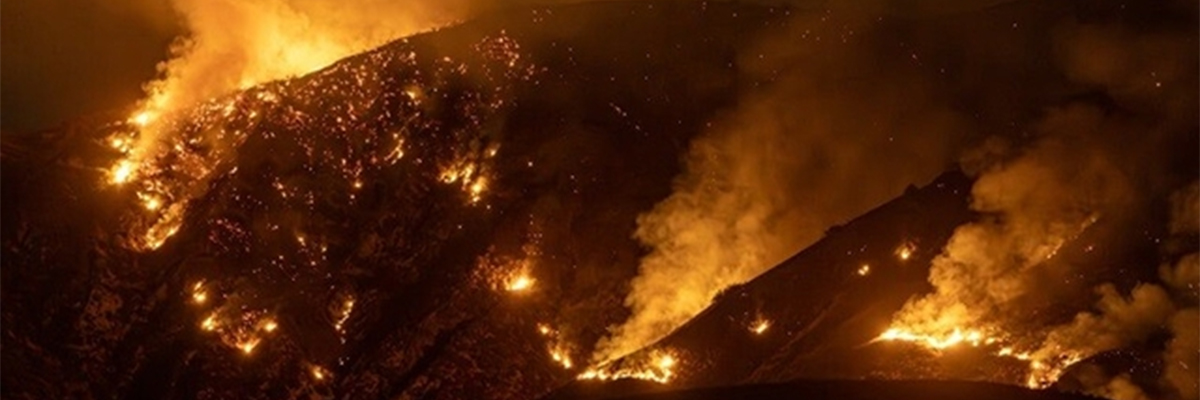Technology companies in Los Angeles and Silicon Valley are volunteering their services, including deploying drones equipped with artificial intelligence (AI) capabilities "to detect outbreaks and get to new fire scenes as quickly as possible," according to NBC Bay Area. The news outlet says these drones "can get closer to the flames than humans and can work with satellites to help map fires."
Many see the use of these technologies as a "rule changer" in the field of firefighting. According to recent reports, climate change, land management practices, and simple human behavior have led to an increase in wildfires in recent years, and emergency responders are turning to new systems to deal with the growing danger. In particular, artificial intelligence is being used to accelerate the processing and organization of large amounts of fire-related information. This information can help firefighters better deploy resources, make decisions and prevent fires from spreading.

California's Commitment to Drone Technology
Los Angeles' current efforts to use unmanned systems, artificial intelligence, and related technologies build on California's longstanding commitment to using drones to fight fires. In a Jan. 13 statement on wildfire response and forest management, California asserted that "Cal Fire has doubled its use of drones for critical tasks such as aerial ignition during prescribed burns, wildfire control and real-time assessments."
The statement added that California has also deployed Artificial Intelligence (AI) LiDAR and 3D maps to provide real-time intelligence to help firefighters "better understand and respond to complex terrain" and improve the way it delivers "evacuation orders, local shelter information, road closures, etc." in the way they communicate. In many cases, these technologies work in tandem with drones to accomplish this critical work.
The current crisis in Los Angeles isn't the first time drones have been used in California to help fight fires. For example, drones played a key role in the Dixie Fire in 2021. According to Inside Unmanned Systems, the drones were equipped with "potassium permanganate pellets that burst into flames when punctured and injected with ethylene glycol." The pellets, called "dragon eggs," help firefighters perform "aerial ignition," a process derived from "backfiring," in which "a fire ignites a patch of flames in a place where the fire has not yet spread," according to Inside Unmanned Systems. where the fire has not yet spread to cut off fuels."
In addition, during the Dixie Fire, some drones were equipped with infrared equipment. This helped firefighters "find hot spots under the grass and provide a safe overhead view."
Drones also assisted with important research during and after California's devastating 2017 and 2018 hill fires. According to Commercial Drone News, "Drones were used in multiple communities to provide aerial damage assessment, mapping, documentation of impacted areas, and to improve situational awareness for emergency response teams in real time."
The Problem of Unauthorized Drones
There are many more examples of drones helping firefighters do important work in California and around the world, but some thorny issues with unmanned vehicles came to the fore during the recent crisis in Los Angeles. These problems were not caused by the officially authorized use of unmanned technology. They were caused by reckless, ignorant and unauthorized drone operators.
As of Wednesday, Jan. 15, three people have been arrested for unauthorized drone flights that hindered emergency response efforts in the Los Angeles area, according to UAS Vision. In one of the incidents, a private drone crashed into a firefighting aircraft known as a Super Scooper, rendering it unable to perform its critical mission.
The UAS Vision report explains, "Temporary flight restrictions were implemented over the wildfire area and federal authorities have deployed ground teams to intercept pilots violating FAA restrictions." In total, local authorities have spotted 48 private drones flying over the wildfire zone.
Drones Benefit the Public
At a time when the many benefits of unmanned systems for firefighting applications are on full display, the careless and non-compliant behavior of these private drone operators has raised serious concerns about the widespread use of unmanned vehicles. These behaviors distract from the positive reports of drone flights benefiting the public.
As contributing writer Carla Lauter recently explained in Commercial Drone News, "While it's easy for those unfamiliar with drone work to imagine the negative possibilities, the truth about drones-especially in commercial and non-military applications-is more beneficial than many people realize." In the U.S. and around the world, the diverse, innovative and well-regulated drone industry is providing countless societal benefits in areas such as public safety, law enforcement and emergency response, she said.
Hopefully, private drone operators will learn important lessons from these incidents in Los Angeles, and that public agencies and regulators will find new ways to curb unauthorized drone activity, keep the public safe, and further promote the use of unmanned systems in emergency operations.
Post time: Jan-21-2025